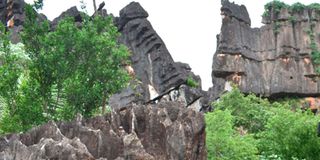Kilifi residents have chosen Chasimba Caves over Sh12bn Mashujaa Cement factory

The 'Mawe Meru' (black rock) at Chasimba Caves in Chonyi, Kilifi South Sub County on July 1, 2022.
Driving along the Mavueni-Kaloleni Highway in Kilifi County, one cannot fail to notice the huge black rocks stacked on one side of the road.
A closer look reveals a wonder of nature where the rocks are naturally arranged to form several caves on the ground and above.
For decades, the Chasimba Caves, known locally as Mawe Meru in the Chonyi language, which translates as Black Rocks, have been treasured by the Mijikenda community for their heritage value.
A tour of the caves reveals ancient coins, which locals say must not be removed as they are believed to have been left there by people seeking spiritual blessings from their gods.
Some ash from burnt pieces of firewood and red and black ribbons hanging from parts of the caves suggest that there may be community members who still use the site as a shrine.
In recent months, however, the locals and environmentalists, who also consider the site to be ecologically valuable, have become concerned.
This is after a company announced its intention to build a cement factory on the site.
Mashujaa Cement Plc has set a budget of Sh12.8 billion for the entire cycle of the project, from feasibility studies to construction.
Although the company's Environmental and Social Impact Assessment report, seen by the Nation, shows that the proposed factory is not on the exact site of the caves, opponents of the plans insist that the caves will be affected by the blasting of rocks.

A local guide, Mr Nicholas Nyale, leads visitors through the Chasimba Caves in Chonyi, Kilifi South Sub County on July 1, 2022.
"The project is located at Pingilikani-Chonyi area, Chasimba location, Kilifi South sub-County in Kilifi County. Mashujaa Cement Plc has obtained land consent forms from the community and purchased the land from the private land owners at Chasimba Location," the company said in its report.
According to the company, the surrounding communities will benefit from employment opportunities and other economic activities that may result from its investment.
It explained that the chosen site is agriculturally unproductive because it is rocky and therefore unfavourable for agriculture and vegetation.
"There is no development in the proposed site area. The project site is open and unfenced with no observable wavy boundary markers, while the land is relatively flat and characterised by a mixture of steep, random and rocky outcrops," the company said.
In a letter to the National Environment Management Authority (Nema), a section of the community opposes the plan, saying it threatens to destroy their cultural heritage.
The signatories claim they were not consulted prior to the preparation of the ESIA report, in violation of their constitutional rights.
"The area where Mashujaa Cement Plc intends to build its cement factory surrounds an eco-cultural site called Mawe Meru, which is of great importance to the local community and conservationists," the letter, dated January 30, 2024, states.
It adds that there is potential for family disputes over the sale of land to the company, fears of pollution and minimal economic benefits for local communities.
According to them, several factories have been set up in Kilifi, but local people rarely benefit, especially in terms of employment.
A team of scientists from Kilifi has been campaigning for the Chasimba Caves to be recognised as a World Heritage Site by the United Nations.
According to the researchers, the caves are a special geological site that could have been used as human dwellings or hiding places during the slave trade of the 16th-18th centuries.
In an interview with the Nation, a senior scientist at the Institute of Primate Research (IPR), Dr Ngalla Jillani, said the presence of fossils in the cave indicated past human activity.
"While I was in the cave, I saw some bones that could have come from anywhere because they were on a rock, and when I examined them, the bones were heavy, which means they had gone through mineralisation.
"They were not modern bones, which means there was a history to these animals or people. I found them very interesting because one was a rib, the other was a skull bone that was around the eye socket, there was one that was the heel on the lower leg bone that connects the long bone of the leg and the short bones of the foot for movement," he said.
According to Dr Jillani, such findings mean that Mawe Meru Cave should be preserved.
He explained that the caves need to be repackaged as a utility with sustainable use and there needs to be a valuable addition to it.
"We are talking about it as a resource, which means that some people can benefit from the heritage site and it is important to preserve that space. If you blow up Mawe Meru, all the rocks will fall and destroy the architecture of the caves," he said.
Dr Joyce Jefwa, a botanist from Pwani University, said the country risks losing important endemic species if such sites are not preserved.
According to Dr Jefwa, some tourists who visit the caves carry seeds of some plants and other unique items and thus if the country loses, foreign countries could benefit by exporting such unique species.
According to Dr Jefwa, Chasimba Caves are a unique formation and a special geo-location with some cultural significance.
In addition to plants, the site is home to a variety of bird, reptile and mammal species.
"Preserving habitats for other biodiversity is very important, otherwise that biodiversity would become extinct. Species migrate and come to you with things that we as humans cannot carry in a reciprocal way.
"Most of the time, we have no idea that even our resources have a high value, and we think it is just a matter of seeing, but not protecting," she said.
Despite its potential as a tourist attraction for more than a century, the Mawe Meru Heritage Site has never provided tangible economic benefits to the community.
However, scientists and community professionals are pushing for the caves to be preserved and marketed as a tourist attraction in Kilifi.






